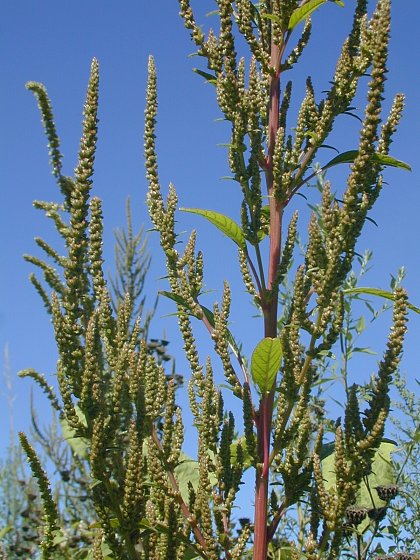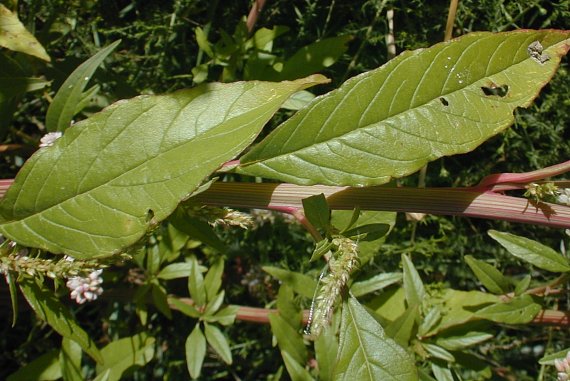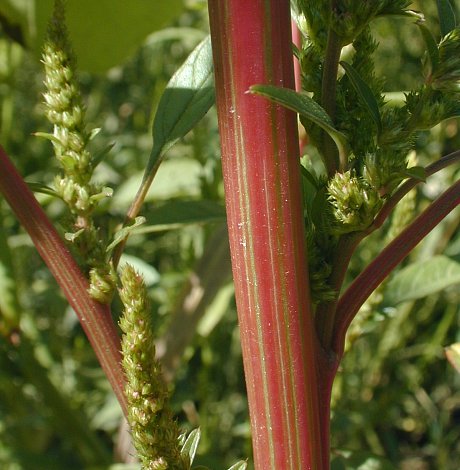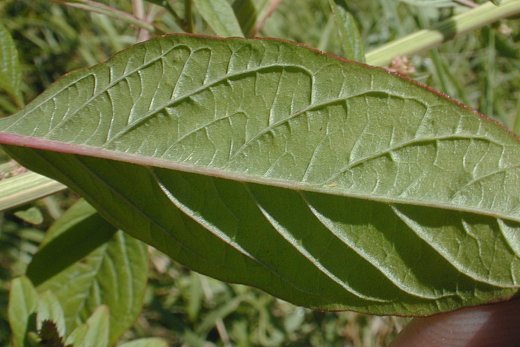Description: This plant is a summer annual; it is highly variable in size, ranging from 2-8' tall. Larger plants branch frequently and are broader at the base than at the top. The hairless stems are either round or ridged, and green or pinkish red. The hairless alternate leaves are up to 6" long and 1½" across. They are lanceolate, ovate-lanceolate, or oblong, with smooth margins and a somewhat shiny upper surface. The petioles are long and narrow, sometimes as long as the leaves, but usually shorter. The flowers are arranged in spikes, or narrow panicles of spikes, up to 1' long. These spikes may develop directly from the upper branches, or they may appear from the axils of the upper leaves.

Water Hemp is dioecious, with individual plants producing either staminate flowers (male) or pistillate flowers (female). Both types of flower are less than 1/8" (3 mm.) long. Each staminate flower consists of 5 sepals, 5 stamens, and no petals; it is surrounded by 1-3 narrow bracts with pointed tips. Each pistillate flower consists of 0-2 sepals (usually 1), an ovary with 3 feathery styles, and no petals; it is surrounded by 1-3 narrow bracts with pointed tips. The bracts of both staminate and pistillate flowers vary in color from green to reddish pink. The flowers and bracts are arranged along the spikes more or less densely, sometimes occurring along the spikes in loose bunches. The blooming period usually occurs from late summer to early fall, and lasts about 1-2 months. There is no floral scent. The pistillate flowers are replaced by ovoid capsules that split cleanly around the middle to release the seeds. Each capsule contains a single small seed. The seeds are flat, round, shiny, and dark brown to black. The root system consists of a taproot. This plant spreads by reseeding itself.

Cultivation:
The
preference is full or partial sun, wet to moist conditions, and fertile
soil consisting of loam or clay loam. This plant will grow in drier
sites with poor soil, but it will be smaller in size. This plant is
rather weedy and can aggressively reseed itself in disturbed areas.
Range & Habitat:
The native Water Hemp is a common plant that occurs in most areas of
Illinois (see
Distribution
Map); it is somewhat less common in southern Illinois.
Probably it is more widespread than the distribution map indicates,
even though this map is derived from a recent source (from Mohlenbrock,
2001). Natural habitats include swampy areas, seasonal wetlands, mudflats, and borders of
small lakes, ponds, or rivers. It also occurs in cultivated fields and
waste areas. This plant definitely prefers disturbed areas, and it is
probably spreading throughout the state.

Faunal
Associations:
The flowers are wind-pollinated and they are not designed to attract
pollinating insects. Many insects feed destructively on Water Hemp
(Amaranthus rudis) and other Amaranthus spp. These insect feeders include the seed-eating adults of Amara aenea (Common Sun Beetle) and other ground beetles, Disonycha glabrata (Pigweed Flea Beetle) and other flea beetles, Conotrachelus seniculus (Amaranth Curculio) and other weevils, leaf-mining larvae of some Anthomyiid flies (Pegomya spp.), Lygus lineolaris (Tarnished Plant Bug) and other plant bugs, Piesma cinerea (Pigweed Bug), Pemphigus betae (Sugar Beet Root Aphid) and other aphids, larvae of of Virbia aurantiaca (Orange Virbia) and other moths, larvae of the skippers Pholisora catullus (Common Sootywing) and Staphylus hayhurstii (Hayhurst's Scallopwing), Spharagemon collare (Mottled Sand Grasshopper) and other grasshoppers, and the seed-eating Gryllus pennsylvanicus (Fall Field Cricket). The Insect Table has a more complete list of these insect feeders. The seeds of Amaranthus spp. are an attractive source of food to the Mourning Dove,
ducks, sparrows, and other songbirds (see Bird Table).
This is
partly because the little seeds are produced in great abundance and
they can
persist through the winter. Ducks are especially likely to feed on the
seeds of Water Hemp because of its preference for disturbed wetland
habitats. Because the foliage of this plant can accumulate high
levels of nitrates, it can be toxic to livestock when it is eaten in
abundance.
Photographic Location:
A mound of soil that was recently deposited by earth-moving equipment
in Champaign, Illinois.

Comments: This little-valued plant is beneficial to wildlife, especially insects and birds. This is just one more example why weedy plants should not be destroyed on sight for trivial reasons. However, it can invade cultivated fields and cause allergic reactions in humans from the wind-borne pollen. Water Hemp (Amaranthus rudis) is very similar in appearance to Western Hemp (Amaranthus tuberculatus), and both species share the same range in Illinois and have similar habitat preferences. However, the seed-containing capsules of Western Hemp split open irregularly with jagged edges, while the capsules of Water Hemp split cleanly and evenly around the middle. This is easy to observe by rubbing the flowering spikes with one's hand, as many of the capsules (along with the bracts and released seeds) will fall readily into one's palm. These two species are sometimes assigned to the Acnida genus because the pistillate flowers usually have a single sepal, whereas the pistillate flowers of other Amaranthus spp. usually have 5 sepals, like the staminate flowers.